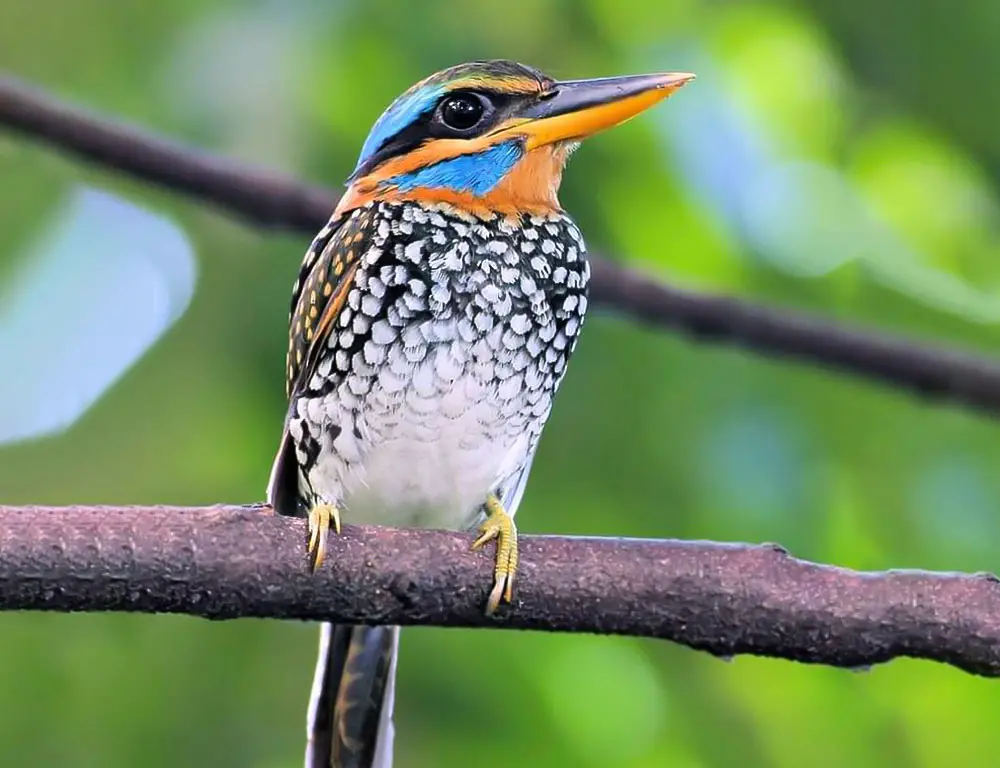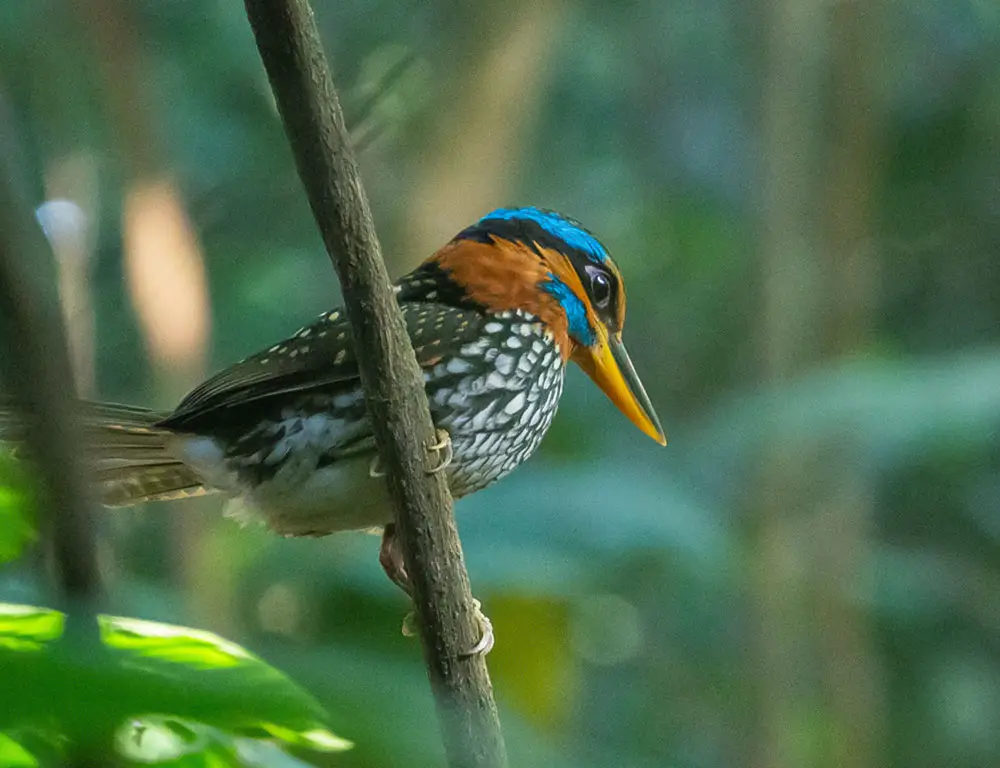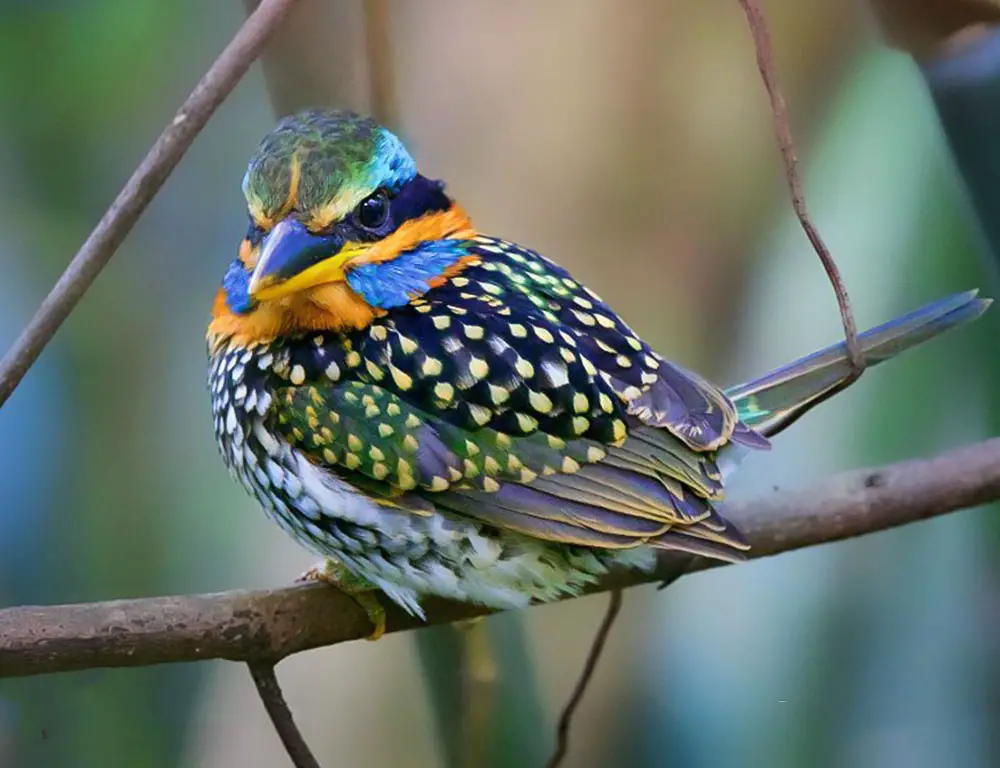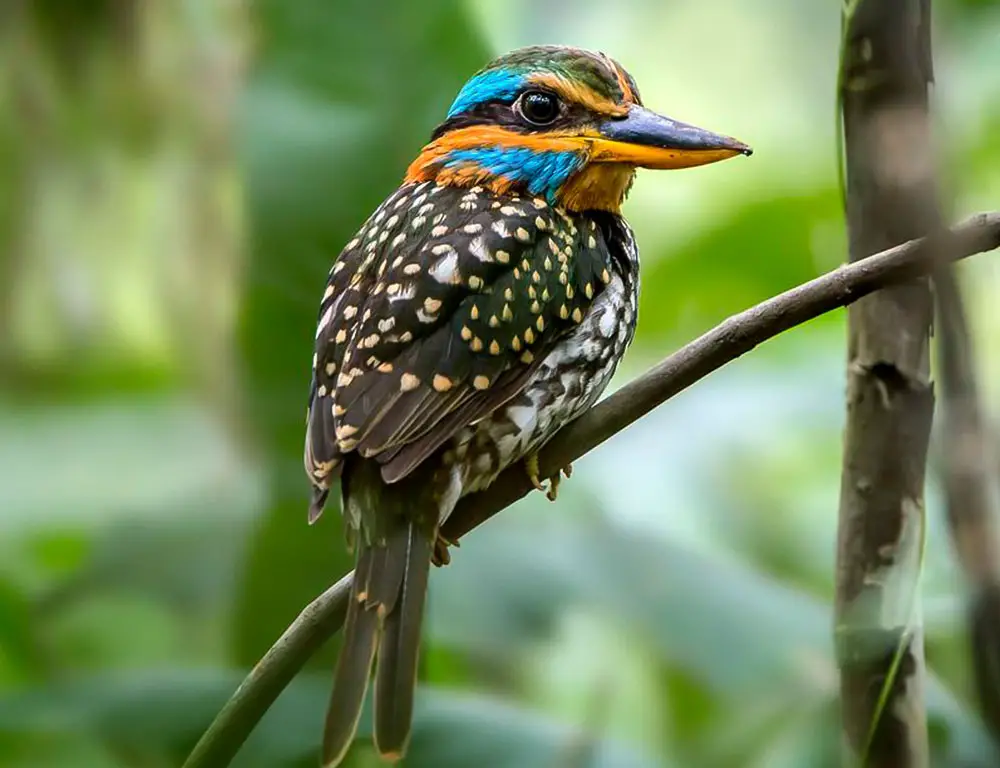Bird enthusiasts are often drawn to discovering new and exotic species. Among these, the Spotted Wood Kingfisher is a captivating gem native to the Philippines.
Its vibrant plumage and enchanting call have enraptured local and international birdwatchers’ hearts.
Sporting a striking combination of azure blue, chestnut, and white spots, this bird presents a visual spectacle in its woodland habitat.
Yet, its appeal extends beyond aesthetics; the Spotted Wood Kingfisher’s behavior patterns, including its preference for land over water habitats, add layers of fascination for researchers and admirers alike.
Join me as we delve into the world of this extraordinary avian species and uncover the secrets of its captivating existence.

Physical Characteristics of Spotted Wood Kingfisher
The Spotted Wood Kingfisher (Actenoides lindsayi) is a visually striking bird with distinct physical characteristics that distinguish it from other species.
Here’s a detailed overview of its physical traits:
Size
The Spotted Wood Kingfisher is a medium-sized bird, typically measuring between 23 to 25 centimeters (9 to 10 inches) in length.
Weight
On average, Spotted Wood Kingfishers weigh around 70 grams (2.5 ounces). However, individual weights may vary slightly depending on age, sex, and overall health.
Coloration
- Head and Upperparts: The head and upperparts of the Spotted Wood Kingfisher exhibit a vibrant azure blue coloration. This blue hue is striking and may appear iridescent under certain lighting conditions.
- Underparts: The bird’s underparts are adorned with a rich chestnut or reddish-brown color, which provides a beautiful contrast to the blue upperparts.
- Spots and Streaks: True to its name, the Spotted Wood Kingfisher features distinctive white spots and streaks on its chest and belly. These markings contribute to its overall appearance and help camouflage it among the foliage.
- Bill: The bill of the Spotted Wood Kingfisher is red-orange, with a black tip. This sharp, pointed bill is well-adapted for capturing prey such as insects and small reptiles.
- Eyes: The bird’s eyes are striking red, framed by dark eye stripes extending toward the back of the head. These features enhance the bird’s visual appeal and may serve various functions, including communication and camouflage.
Legs and Feet
The legs and feet of the Spotted Wood Kingfisher are typically olive-green in color. These sturdy appendages are well-suited for perching on branches and navigating its forest habitat.
Habitat and Distribution of Spotted Wood Kingfisher

The Spotted Wood Kingfisher (Actenoides lindsayi) is primarily found in Southeast Asia, with a particular emphasis on certain regions and habitats.
Here’s a detailed overview of its habitat and distribution:
Preferred Habitat
- Tropical Forests: Spotted Wood Kingfishers prefer dense tropical forests and woodlands as their primary habitat. These forests provide ample cover and a rich diversity of prey, making them ideal hunting grounds for the birds.
- Lowland Habitats: While primarily associated with lowland forests, Spotted Wood Kingfishers have also been known to inhabit other lowland habitats such as plantations, gardens, and even areas along roadsides. This adaptability allows them to thrive in various environments within their range.
- Altitude: Spotted Wood Kingfishers typically inhabit areas below 1000 meters (3280 feet) above sea level. However, they have been recorded at higher altitudes, with sightings reported at elevations of up to 1750 meters (5740 feet).
Geographical Range
- Philippines: The Spotted Wood Kingfisher is indigenous to the Philippines, where it is found across various islands, including Mindanao and Luzon.
These islands provide diverse habitats, including lush forests and wooded areas, which support healthy species populations. - Southeast Asia: Beyond the Philippines, Spotted Wood Kingfishers are also found in other countries across Southeast Asia, including Thailand, Malaysia, and Indonesia. Their distribution may vary within these countries, with localized populations inhabiting specific regions.
- Borneo: Notably, a subspecies of the Spotted Wood Kingfisher, Actenoides lindsayi vidali, is exclusively found on the island of Borneo. This subspecies further underscores the species’ adaptability to different environments within its range.
Behavior and Diet of Spotted Wood Kingfisher

The behavior and diet of the Spotted Wood Kingfisher (Actenoides Lindsay) are fascinating aspects of its ecology, showcasing its adaptability and unique hunting strategies.
Here’s an overview of the behavior and diet of this captivating bird:
Feeding Habits
- Diet: Despite its name, the Spotted Wood Kingfisher primarily feeds on insects and small reptiles rather than fish.
Its diet includes a variety of prey, such as beetles, grasshoppers, caterpillars, and small lizards. Occasionally, they may also consume small rodents and other vertebrates. - Hunting Strategy: Spotted Wood Kingfishers are adept hunters who employ various strategies to capture prey. They use sharp, pointed bills like spears, diving down from perches to snatch insects and small reptiles. Their keen eyesight allows them to spot prey from a distance, enabling accurate strikes.
Activity Patterns
- Crepuscular Feeding: Spotted Wood Kingfishers are crepuscular feeders, meaning they are most active during dawn and dusk. These periods offer optimal lighting conditions for hunting, as many insects and small prey species are active during these times.
- Territorial Behavior: Like many bird species, Spotted Wood Kingfishers exhibit territorial behavior, especially during breeding. They defend territories within their preferred habitats, using vocalizations and displays to deter intruders.
Breeding Behavior
- Nesting: Spotted Wood Kingfishers are cavity nesters, utilizing natural tree hollows or excavating burrows in earthen banks for nesting sites. Both male and female birds participate in excavating the nest cavity using their powerful bills.
- Incubation and Parental Care: After the nest is constructed, the female lays a clutch of 2-5 eggs, which are incubated alternately by both parents for about 18 days. After hatching, both parents take turns feeding and caring for the chicks until they fledge, typically around four weeks after hatching.
- Courtship Displays: During the breeding season, male Spotted Wood Kingfishers engage in elaborate courtship displays to attract mates. These displays often involve vocalizations and visual cues, such as fluffed feathers and wing displays, to impress potential partners.
Social Behavior
While Spotted Wood Kingfishers may form breeding pairs during the reproductive season, they are typically solitary hunters outside the breeding context. They forage alone or in pairs, maintaining individual territories within their preferred habitats.
Conservation Status of Spotted Wood Kingfisher

The conservation status of the Spotted Wood Kingfisher (Actenoides lindsayi) is a topic of concern, given the ongoing threats to its habitat and population.
Here’s an overview of its conservation status and associated challenges:
IUCN Red List Status
The Spotted Wood Kingfisher is classified as a species of “Least Concern” on the International Union for Conservation of Nature (IUCN) Red List. This designation implies that the species does not currently meet the criteria to be classified as threatened or endangered.
Population Trends
While the species is not considered globally threatened, specific populations may face localized threats and declines due to habitat loss, fragmentation, and degradation.
Population trends may vary across its range, with some areas experiencing declines while others remain stable.
Habitat Loss and Degradation
One of the primary threats to Spotted Wood Kingfishers is habitat loss and fragmentation due to deforestation, agricultural expansion, logging, and urbanization.
These activities result in the loss of suitable forest habitats and nesting sites, reducing the availability of prey and increasing competition for resources.
Climate Change
Climate change poses additional challenges to the Spotted Wood Kingfisher and other avian species.
Shifts in temperature and precipitation patterns can alter habitat suitability, disrupt breeding cycles, and affect prey availability, potentially impacting population dynamics and distribution.
Human Disturbance
Human activities such as infrastructure development, tourism, and recreational activities can disturb Spotted Wood Kingfisher habitats, leading to habitat disturbance, nest abandonment, and increased stress on populations.
Conservation Efforts
Conservation efforts to protect the Spotted Wood Kingfisher and its habitat include establishing protected areas, habitat restoration initiatives, community-based conservation projects, and research and monitoring programs.
These efforts seek to mitigate the impacts of habitat loss and address other threats facing the species.
Public Awareness and Education
Raising public awareness about the importance of conserving the Spotted Wood Kingfisher and its habitat is crucial for garnering support for conservation initiatives.
Education programs, outreach activities, and ecotourism initiatives can help promote appreciation for the species and its ecological role.
Now let’s take a look at some numbers:
| Year | Population Estimate |
|---|---|
| 2000 | Over 10,000 |
| 2010 | Decreased by 20% |
| 2020 | Stable |
FAQs
How does the Spotted Wood Kingfisher build its nest?
The Spotted Wood Kingfisher excavates burrows in tree trunks or earthen banks for nesting sites, utilizing its powerful bill.
What is the average lifespan of a Spotted Wood Kingfisher?
Spotted Wood Kingfishers can live up to 11 years in the wild.
Do Spotted Wood Kingfishers migrate?
Spotted Wood Kingfishers are typically sedentary birds and do not migrate over long distances. However, they may undertake local movements for food or suitable nesting sites.
How do Spotted Wood Kingfishers communicate?
Spotted Wood Kingfishers communicate through various vocalizations, including calls and songs, which play a role in territory defense and courtship displays.
Are Spotted Wood Kingfishers monogamous?
Spotted Wood Kingfishers are known to form monogamous breeding pairs during the reproductive season, with both parents participating in incubation and chick rearing.
Conclusion
The Spotted Wood Kingfisher is a captivating bird indigenous to the Philippines, renowned for its vibrant plumage, distinct call, and unique adaptations.
Thriving in primary and secondary forests, it showcases resilience amidst changing landscapes.
Despite its terrestrial hunting habits, it stands out among its aquatic relatives. While population numbers remain relatively robust, ongoing deforestation significantly threatens its habitat.
Prioritizing conservation efforts is crucial to ensuring the survival of this species for future generations to marvel at.
As our understanding of this fascinating bird grows, there’s much more to discover about its secrets and ecological significance.
Let’s cherish nature’s beauty and continue our efforts to preserve the habitats of these winged wonders.